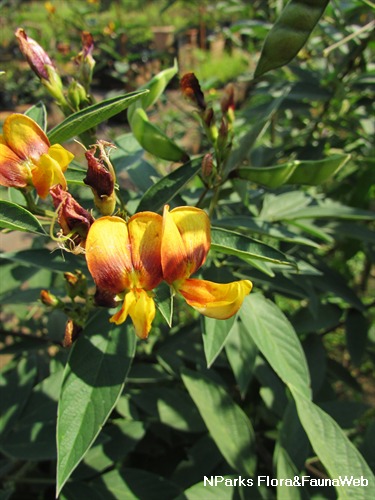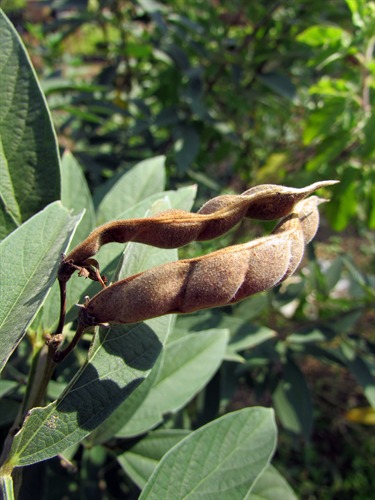
Back
Cajanus cajan (L.) Millsp.
| Family Name: | Fabaceae (Leguminosae) |
| Common Name: | Congo Pea, Pigeon Pea, Yellow Dhal |
Name
Classifications and Characteristics
| Plant Division | Angiosperms (Flowering Seed Plants) (Dicotyledon) |
|---|---|
| Plant Growth Form | Shrub |
| Lifespan (in Singapore) | Semi-Annual / Annual-Like |
Biogeography
| Native Distribution | Africa, India, Sri Lanka |
|---|---|
| Native Habitat | Terrestrial |
| Preferred Climate Zone | Tropical, Sub-Tropical / Monsoonal |
Description and Ethnobotany
| Growth Form | It is an erect shrub which grows up to 4 m tall and has a deep tap root, up to 2 m. |
|---|---|
| Foliage | Foliage are alternately arranged along the stems, tri-foliate; petiolate, measures 1 - 8 cm long; leaf blade elliptical to lanceolate, measures 3 - 13 cm long and 1 - 5 cm wide, pubescent, green above and greyish-green below. |
| Flowers | Inflorescence, raceme, axillary; yellow, papilionaceous (belonging to the subfamily of Papilionoideae, same as pea flower); each individual flower has a total of 10 stamens, 9 are fused together into a tube while the other one is free; style is curved. |
| Fruit | A straight or sickle-shaped pod, slightly inflated, measures 2 - 13 cm long and 0.5 - 1.5 cm wide, pubescent, each pod containing up to to 9 seeds, each seed measures about 4 - 9 mm, round to oval, colours vary from brown, black to beige. |
| Cultivation | Widely cultivated in India with other crops such as sorghum, sesame and corn. |
| Etymology | The genus Cajanus and specific epithet cajan come from the Malay vernacular name, 'katjang' which means pigeon pea. |
| Ethnobotanical Uses | Edible Plant Parts : Edible Seeds Food (Fruit or Vegetable): The seeds are used as dhal in India and as substitute for soy beans in other parts of Asia for making tofu or tempe. They are also canned in Puerto Rico and Trinidad. Medicinal: Its leaves are used to treat diarrhoea, burns, sore throat, dizziness and epilepsy. Its roots are also used to treat cough and stomach problems Agriculture - Forestry: Used as perennial forage crop or used as green manure due to ability in nitrogen fixing. Others: Its leaves and seed pods are used as animal feed, while the stems can be used as firewood. |
Landscaping Features
| Desirable Plant Features | Ornamental Flowers, Ornamental Foliage |
|---|---|
| Landscape Uses | General |
Plant Care and Propagation
| Light Preference | Full Sun |
|---|---|
| Water Preference | Little Water |
| Rootzone Tolerance | Drought Tolerant, Well-Drained Soils, Easy to Grow |
| Propagation Method | Seed |
Foliar
| Foliage Retention | Evergreen |
|---|---|
| Mature Foliage Texture(s) | Velvety / Furry / Tomentose |
| Foliar Type | Compound (Trifoliate) |
| Foliar Arrangement Along Stem | Alternate |
| Foliar Attachment to Stem | Petiolate |
| Foliar Shape(s) | Non-Palm Foliage (Lanceolate, Elliptical) |
| Foliar Venation | Pinnate / Net |
| Mature Foliage Colour(s) Remarks | Green above, greyish-green below. |
Floral (Angiosperm)
| Flower & Plant Sexuality | Bisexual Flowers |
| Flower Colour(s) | Yellow / Golden |
|---|---|
| Flower Grouping | Cluster / Inflorescence |
| Flower Location | Axillary |
| Individual Flower Shape | Papilionaceous / Pea-shaped |
| Inflorescence Type | Raceme |
Fruit, Seed and Spore
| Mature Fruit Colour(s) | Brown, Black |
|---|---|
| Mature Fruit Texture(s) | Velvety / Furry / Tomentose |
| Fruit Classification | Simple Fruit |
| Mature Seed Colour(s) | Black, Brown, Patterned |
| Seed Quantity Per Fruit | Moderate (6-10) |
Image Repository
Others
| Master ID | 32559 |
|---|---|
| Species ID | 6971 |
| Flora Disclaimer | The information in this website has been compiled from reliable sources, such as reference works on medicinal plants. It is not a substitute for medical advice or treatment and NParks does not purport to provide any medical advice. Readers should always consult his/her physician before using or consuming a plant for medicinal purposes. |



